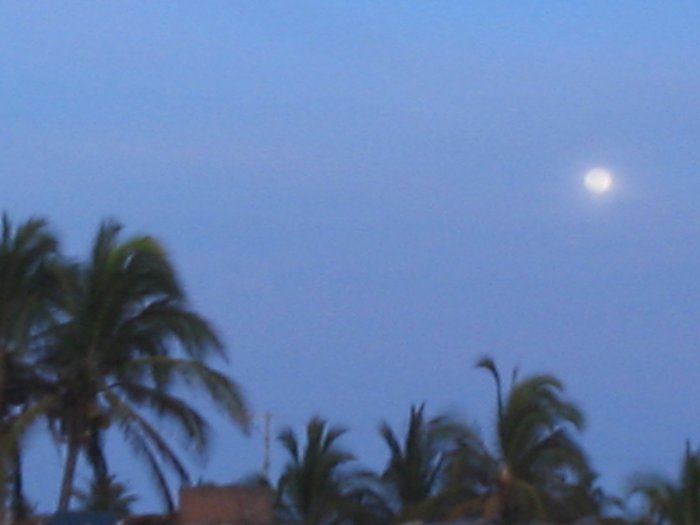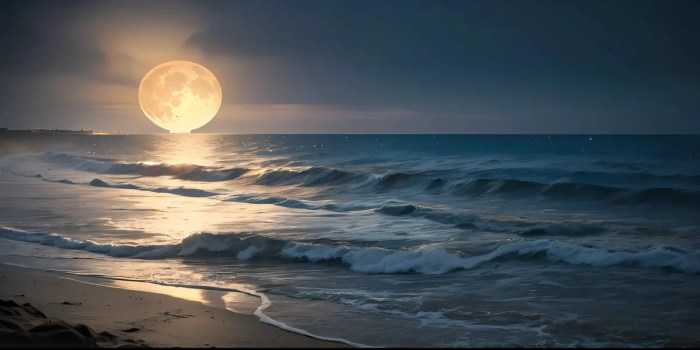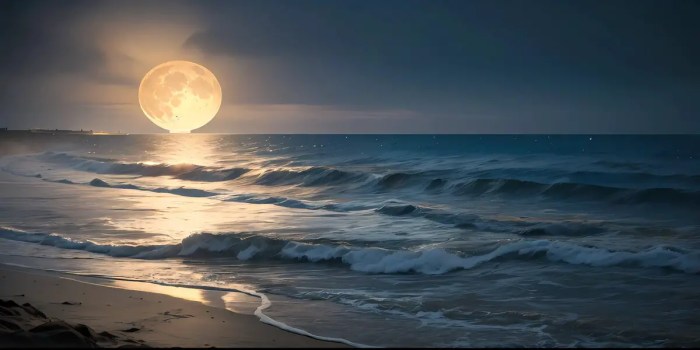Beach on the moon, a seemingly impossible concept, becomes surprisingly tangible when we explore the potential for a lunar beach. Imagine pristine, albeit unique, sands under a pale sun, with the breathtaking backdrop of the inky black sky. This post delves into the fascinating possibility of establishing a lunar beach, exploring its geological features, potential infrastructure, and the exciting prospects it holds.
From the composition of the lunar “sand” to the design of visitor centers, we’ll examine the scientific and logistical challenges and opportunities that come with creating this extraordinary destination. We’ll also consider the ethical and societal implications of bringing such a remarkable project to life.
Conceptual Exploration of a Lunar Beach
A lunar beach, a seemingly impossible concept, becomes intriguing when we delve into the possibilities of a hypothetical landscape on the Moon. Imagine a vast expanse of “sand” stretching beneath a stark, alien sky, bathed in the unique light of our celestial neighbor. This exploration will delve into the potential geological, environmental, and even biological aspects of this unique lunar terrain.The Moon, devoid of significant atmosphere and liquid water, presents a challenging environment for the formation of traditional beaches.
Yet, the presence of impact craters, regolith, and other geological formations offers a framework for envisioning a lunar beach, albeit with considerable differences from Earth’s beaches.
Lunar Beach Geology
The “sand” on a lunar beach would likely consist of pulverized rock, or regolith, originating from the impact of meteoroids and asteroids over eons. This fine, powdery material, known as lunar dust, is incredibly abundant on the lunar surface. The impact events that created these craters and pulverized the bedrock also contributed to the unique characteristics of the regolith.
This material’s composition and texture would be significantly different from Earth’s sand, likely exhibiting a greyish or dark coloration. The absence of water would drastically alter the shaping forces that mold terrestrial beaches.
Environmental Conditions
The extreme environmental conditions of the Moon present a significant contrast to Earth’s beaches. Temperatures on the lunar surface fluctuate wildly between scorching highs during the lunar day and frigid lows during the lunar night, often reaching hundreds of degrees Celsius. The almost complete absence of an atmosphere means minimal atmospheric pressure, a stark difference from the 1 atmosphere pressure on Earth.
Dreaming of a beach on the moon? While we’re still waiting for lunar sandcastles, checking out the new Solo: A Star Wars Story trailer featuring Donald Glover is a pretty cool alternative. Watch the new Solo a Star Wars story trailer with Donald Glover to see some seriously impressive space adventures. It’s a far cry from the moon, but it gets you thinking about how awesome a beach on the moon could actually be, wouldn’t it?
Sunlight, while intense during the lunar day, would be drastically different in quality and intensity from Earth’s sunlight due to the distance from the Sun and the lack of atmospheric filtering. The lack of a significant atmosphere would mean that there is no shielding against solar radiation.
Compositional Comparison
| Feature | Lunar Beach | Earth Beach ||—|—|—|| Composition | Pulverized rock (regolith), varying particle sizes | Primarily quartz, other minerals, varying particle sizes || Temperature | Extreme temperature fluctuations (highs and lows) | Moderate temperature range || Water | Absent | Present || Atmosphere | Negligible | 1 atmosphere |
Potential Ecosystem
Given the harsh conditions, the development of a truly robust ecosystem on a lunar beach is highly improbable in the foreseeable future. However, extremophile organisms, which thrive in extreme environments on Earth, provide a fascinating framework for imagining potential life forms adapted to the unique conditions of a lunar beach. Any such life would likely be extremely resilient, needing to adapt to the extreme temperature fluctuations, lack of liquid water, and intense radiation.
The potential for microbial life or even more complex organisms adapted to these conditions remains a topic of ongoing scientific inquiry.
Lunar Beach Infrastructure and Technology: Beach On The Moon
The concept of a lunar beach, while intriguing, presents significant engineering challenges. Creating a sustainable and safe environment on the Moon demands innovative solutions for infrastructure and resource management. These solutions must consider the unique characteristics of the lunar environment, including the lack of atmosphere, extreme temperature fluctuations, and the presence of micrometeoroids.Constructing any infrastructure, from simple shelters to complex settlements, requires careful consideration of the available resources and the technology to utilize them.
This includes understanding how to procure and process materials on the lunar surface and how to power systems without relying heavily on Earth-based support.
Construction Technologies
The construction of lunar infrastructure will necessitate the development of specialized technologies for extracting and processing lunar regolith. This involves understanding the chemical composition of the regolith and developing methods for its sintering and shaping. 3D printing, using regolith as a raw material, offers a potentially efficient and adaptable solution. Advanced robotic systems will be crucial for automating the extraction, processing, and construction processes, reducing the need for frequent astronaut intervention.
Artificial Habitats and Shelters
Creating safe and comfortable habitats on the Moon requires innovative architectural solutions. Modular structures, designed to be easily assembled and disassembled, would offer flexibility and adaptability to changing needs. These structures should incorporate thermal insulation to mitigate extreme temperature variations. Consideration of radiation shielding is critical, given the Moon’s lack of a protective atmosphere. Advanced materials and designs that can withstand micrometeoroid impacts are also necessary for long-term sustainability.
Transportation Systems
Efficient transportation systems are essential for moving people and materials across the lunar surface. Electric vehicles, powered by solar or nuclear energy sources, could be used for short-range transport. For longer distances, advanced rover technology capable of traversing diverse terrains, including potentially the lunar “beach,” will be required. Consideration must be given to the unique challenges of lunar gravity and the need for autonomous navigation.
The design and development of these systems must incorporate robust redundancy and fail-safes for mission success.
Resource Requirements and Sources, Beach on the moon
| Resource | Source | Quantity | Processing Method |
|---|---|---|---|
| Regolith | Lunar surface | Large quantities | Extraction, sintering, 3D printing |
| Water ice | Polar craters, regolith | Variable | Extraction, processing |
| Construction materials (metals) | Potential lunar resources | Variable | Extraction, refining |
| Power | Solar energy, nuclear fission reactors | Variable | Generation, distribution |
The table above highlights the crucial resources needed for a lunar beach settlement. The quantity of resources needed will vary depending on the size and scope of the settlement. Extracting and processing lunar resources in situ will be crucial for minimizing reliance on Earth-based supply chains.
Safety Protocols
The unique lunar environment presents specific safety concerns for both astronauts and equipment. Radiation shielding will be necessary to protect against solar and cosmic radiation. Protective clothing and life support systems are essential for dealing with extreme temperatures and the vacuum of space. Protocols for dealing with micrometeoroid impacts, dust storms, and equipment malfunctions are critical. These protocols should be rigorously tested and updated based on ongoing research and operational experience.
Potential Activities and Uses

A lunar beach, while seemingly a fantastical concept, presents a wealth of potential activities and uses, spanning recreation, scientific research, and economic development. The unique environment offers opportunities unlike anything found on Earth, prompting innovative approaches to exploration and utilization. The presence of a lunar beach could transform space tourism and research, unlocking new frontiers of human endeavor.The development of a lunar beach necessitates a robust understanding of its characteristics and limitations.
This includes analyzing the composition of the lunar “sand,” the presence of resources, and the effects of the lunar environment on human activities and equipment. This careful consideration will be crucial to making the lunar beach a successful and sustainable venture.
Recreational Activities
The unique aesthetic and environment of a lunar beach can offer thrilling and unforgettable experiences. Imagine strolling along the “seashore,” with the Earth rising in the lunar sky as a breathtaking backdrop. Recreational activities could include: moon-gazing, surfing the gentle lunar waves (if any), collecting lunar “sand” specimens, and simply enjoying the unique panoramic views. These activities would be adapted to the lunar environment, using specialized equipment and procedures for safety and practicality.
Scientific Research
A lunar beach could become a hub for scientific exploration. The composition of lunar “sand” and the presence of potential resources could provide insights into the formation and evolution of the Moon. Research could focus on: analyzing the chemical makeup of the lunar “sand” for clues to the Moon’s history; studying the effects of solar radiation on materials exposed on the surface; and exploring the potential for using lunar resources for future space missions.
This research would advance our understanding of the Moon and its potential for future human endeavors.
Economic Opportunities
The establishment of a lunar beach could create significant economic opportunities. This includes the development of new industries, the creation of jobs, and the potential for significant revenue generation. Space tourism, resource extraction, and scientific research could be substantial revenue sources. Lunar “sand” could be a valuable commodity, with various potential applications in materials science and construction.
A thriving ecosystem of businesses would arise to support the activities on the lunar beach.
Potential Business Models
The table below Artikels potential business models and estimated profit margins for a lunar beach operation. These are projections and subject to various factors. Actual results may vary significantly.
| Business Model | Description | Estimated Initial Investment (USD) | Estimated Annual Profit Margin (USD) |
|---|---|---|---|
| Space Tourism Packages | Offering guided tours and accommodation on the lunar beach | 10,000,000 | 2,000,000 |
| Lunar Resource Extraction & Processing | Mining and refining lunar materials | 25,000,000 | 5,000,000 |
| Scientific Research Facilities | Providing space for scientists and researchers to conduct experiments | 5,000,000 | 1,500,000 |
| Lunar Souvenir Shops | Selling unique lunar-themed products | 500,000 | 150,000 |
Visitor Center Design
A visitor center on the lunar beach would need to be highly adaptable to the unique lunar environment. It should be designed for both practicality and aesthetics. The design should include:
- Protective Shelters: Robust, modular shelters to protect visitors from extreme temperature fluctuations and radiation.
- Life Support Systems: Integrated life support systems to maintain a habitable environment.
- Observation Decks: Elevated observation decks for panoramic views of the lunar landscape and the Earth.
- Exhibits: Educational exhibits detailing the history of lunar exploration and the unique characteristics of the lunar beach.
- Accommodation: Modular and sustainable living quarters for extended stays.
The design should prioritize sustainability and resource efficiency.
Ethical and Societal Implications
Creating a lunar beach, while seemingly a futuristic marvel, presents a complex tapestry of ethical and societal considerations. Beyond the technological hurdles, we must ponder the potential ramifications on the lunar environment, future generations, and the very definition of human progress in space. The potential for both immense benefit and unforeseen harm requires careful scrutiny before embarking on such a project.
Ethical Considerations of Lunar Beach Establishment
The establishment of a lunar beach raises several ethical dilemmas. Primarily, the concept of ownership and access to lunar resources must be addressed. Is the lunar surface a shared resource for all humanity, or will it be controlled by specific nations or corporations? Establishing clear guidelines and international agreements to govern resource extraction and usage is paramount to avoid conflicts and ensure equitable distribution of benefits.
Furthermore, potential environmental damage resulting from infrastructure construction and operations must be meticulously assessed and mitigated.
Potential Environmental Impact on the Lunar Surface
The creation of a lunar beach will inevitably impact the pristine lunar environment. Introducing materials like water and sand will alter the existing lunar regolith, potentially affecting the delicate balance of the lunar surface. The introduction of Earth-based organisms, even microscopic ones, could have unforeseen consequences on the lunar ecosystem. Carefully designed procedures and materials must be employed to minimize the ecological footprint of the project.
Social Implications of a Lunar Beach for Future Generations
A lunar beach could have profound social implications for future generations. It could inspire a new generation of scientists, engineers, and explorers, fostering a passion for space exploration and scientific discovery. However, access to this unique environment must be equitable and accessible to all, avoiding the creation of a privileged space tourism sector. The potential for economic disparities and the ethical considerations of resource allocation must be carefully considered.
Ever imagined a beach on the moon? It’s a fascinating concept, but what about focusing on something a little more grounded – like our own lives? Reflecting on our experiences, struggles, and triumphs, is actually quite similar to picturing a lunar beach. It’s a journey of discovery, and exploring those personal landscapes can be deeply rewarding. Thinking about writing about your own life, like a personal lunar explorer charting the terrain of your own emotions, might just reveal a hidden beauty within you.
That’s why I’m encouraging you to check out Write About Your Own Life – to understand how to tell your story. It’s a great starting point to explore the personal journeys that can inspire even the most outlandish dreams, like a beach on the moon.
Comparison of Potential Benefits and Drawbacks of a Lunar Beach
A lunar beach presents a range of potential benefits and drawbacks. The allure of a new recreational and tourism destination in space is undeniable. It could boost scientific research, spur innovation in construction materials and water management, and even provide inspiration for artistic expression. However, the immense cost of development, the potential environmental impact, and the need for international cooperation must be weighed against the potential benefits.
Key Stakeholders and Their Roles in Lunar Beach Development
Several key stakeholders will play crucial roles in the development of a lunar beach. International space agencies, private companies, and academic institutions will collaborate on the technological and scientific aspects of the project. Governments will need to establish international agreements on resource management and environmental protection. The public will also have a crucial role in shaping the project’s direction through public discourse and engagement.
These stakeholders must work together to ensure that the project is environmentally responsible and benefits all of humanity.
Imagine a beach on the moon, bathed in ethereal sunlight. It’s a fascinating concept, isn’t it? This thought-provoking idea, though, is oddly reminiscent of the new release, “still corners creatures of an hour” new release still corners creatures of an hour , which explores similar themes of strange, isolated beauty. Perhaps a beach on the moon isn’t so far-fetched after all, if we can embrace the unexpected and the extraordinary.
Visualizations and Illustrations

A lunar beach, a seemingly impossible concept, takes on a tangible form through vivid visualizations. Imagining this extraterrestrial landscape allows us to better grasp the potential challenges and wonders of a future lunar presence. These visualizations become crucial tools for planning, inspiring, and ultimately, realizing a human presence on the Moon.
Lunar Beach Scene
The lunar beach, unlike its terrestrial counterpart, is sculpted by the forces of impact cratering and the subtle effects of solar radiation. Vast, undulating plains of fine, grey-white lunar dust, resembling crushed glass, stretch out to the horizon. The absence of atmosphere means a stark contrast between the dark, shadowed craters and the bright, sun-drenched areas. This landscape is punctuated by occasional, jagged rock formations, remnants of ancient impacts, casting long, dramatic shadows.
The overall impression is one of immense emptiness and quiet grandeur, a stark beauty unlike anything on Earth.
Lunar Beach at Sunrise/Sunset
Sunrise and sunset on the Moon present a unique visual spectacle. The muted colors of the lunar landscape take on a vibrant quality as the sun grazes the horizon. The soft, diffused light of sunrise and the warm, fiery hues of sunset paint the lunar surface in a kaleidoscope of subtle shades. This is further enhanced by the absence of atmospheric scattering, which allows the true colors of the dust to be revealed.
These transitions would be particularly breathtaking, with the stark contrasts of light and shadow accentuated by the overall emptiness of the lunar environment.
Lunar Sand
Lunar regolith, the layer of loose dust and debris covering the lunar surface, forms the “sand” on the lunar beach. Its texture is remarkably fine, almost like powdered glass. Colors range from light grey to a very pale white, depending on the minerals present. The sand would likely be incredibly dry and statically charged, possibly clinging to clothing or instruments.
It’s a very different material from the familiar grains of Earthly sand.
Lunar Plants and Animals
Currently, there is no evidence of plants or animals existing on the Moon. Given the extreme conditions of temperature, radiation, and vacuum, any life forms would require unique adaptations. However, future exploration and research might reveal unexpected forms of life, possibly microscopic or extremophile organisms.
Lunar Beach Habitat
A lunar beach habitat would need to address the unique challenges of the lunar environment. Structures would likely be dome-shaped or cave-like, integrated into the landscape to minimize exposure to radiation and extreme temperature fluctuations. The habitat’s design would emphasize thermal insulation and shielding from micrometeoroids. Solar panels, positioned strategically, would be vital for energy generation. The habitat would likely incorporate a lunar regolith processing system to create building materials and potentially life support systems.
Large windows could offer stunning views of the lunar landscape.
Closing Summary
The concept of a beach on the moon, while ambitious, offers a compelling vision for the future of space exploration and human settlement. It sparks creativity, demands innovative solutions, and ultimately raises profound questions about our relationship with the cosmos and our place within it. This journey to the lunar shores promises not only an exciting adventure but also a chance to shape a new chapter in human history.

